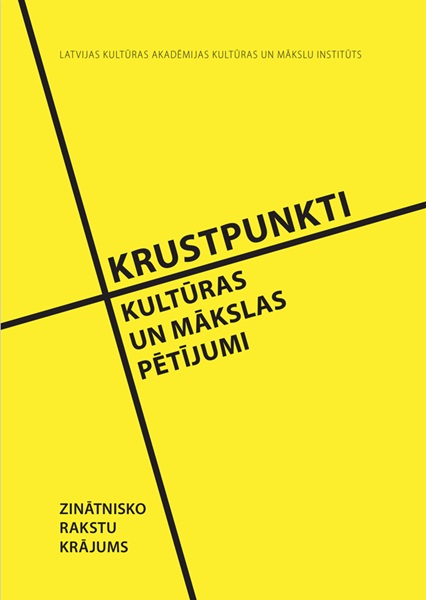ASSESSMENT OF THE EMPLOYMENT SITUATION OF WOMEN IN THE LATVIAN FILM INDUSTRY
DOI:
https://doi.org/10.55877/kkmp.2024.3.592Keywords:
gender equality, film industry, creative industries, female employmentAbstract
In this paper the author focuses on the employment situation of women in the behind-the-scenes professions of the Latvian film industry. This research paper is structured into three sections. The first section will examine employment in the creative industries, with a focus on employment trends related to gender equality. The second section will analyze theoretical sources on employment and gender equality in the film industry, along with statistical data on women's employment in the European film sector. The third section will utilize a mixed-methodology approach to conduct a content analysis of personnel involved in Latvian films, as well as gather insights from film industry professionals on women's employment in Latvia. Both primary and secondary data will be used. Primary data will be collected through in-depth, semi-structured interviews with experts in the film industry, while secondary data will be gathered through content analysis.
Work in the creative industries, especially in the film industry, is characterized by precarious employment. Gender equality is essential to promote equal opportunities and rights, regardless of gender, and to encourage the creation of diverse content in the film industry.
Research shows that women are less represented than men in key creative positions in the film industry in Latvia, including directors. Men dominate the roles of cinematographers, composers and sound engineers – there are very few women working in these professions, while make-up and costume design are dominated by women. The profession of producer has the smallest gender gap. Overall, the Latvian film industry does not have a marked gender gap, so women have the opportunity to work and develop in the film industry without significant barriers or discrimination.
Downloads
References
Latvijas Kinematogrāfistu savienība (2023). Lielais Kristaps (arhīvs). Pieejams: https://www.lielaiskristaps.lv/arhivs/2020/filmas/pilnmetrazas-spelfilmas (skatīts 15.05.2023.)
Leslie, D., Catungal, J., P. (2012). Social justice and the creative city: class, gender and racial inequalities. Geography compass. Volume 6, Issue 3, pp. 117 p. Available: https://doi.org/10.1111/j.1749-8198.2011.00472.x. [accessed 20.04.2023].
Babugura, A. (2017). Gender Equality: A Cornerstone for a Green Economy. 9 p. Available: http://www.jstor.org/stable/resrep28351. [accessed 18.04.2023].
Conor, B., Gill, R., Taylor, S. (2015). Gender and creative labour. The sociological review, Vol. 63, Issue 1, pp. 11. Pieejams: https://doi.org/10.1111/1467-954X.12237 (skatīts 26.04.2023.)
European Audiovisual Observatory (2018). Gender imbalances in the audiovisual industries. Summary of the EAO workshop. Pieejams: https://rm.coe.int/gender-imbalances-in-the-audiovisual-industries/1680946134 (skatīts 26.04.2023.)
Eiropas Komisija (2020). Komisijas paziņojums Eiropas Parlamentam, Padomei, Ekonomikas un sociālo lietu komitejai un Reģionu komitejai. Savienība, kurā valda līdztiesība: dzimumu līdztiesības stratēģija 2020.-2025. gadam. 1-2. lpp. Pieejams: https://eur-lex.europa.eu/legal-content/LV/TXT/PDF/?uri=CELEX:52020DC0152. [skatīts 14.04.2023.].
Eurostat (2022). Cultural employment, 2021. Pieejams: https://ec.europa.eu/eurostat/statistics-explained/index.phptitle=Culture_statistics_-_cultural_employment#Characteristics_of_cultural_employment_in_2021. (skatīts 28.03.2023.)
European Women’s Audiovisual Network (2023). EWA Network study on gender inequality in the film industry. Pieejams: https://www.ewawomen.com/research/ (skatīts 08.03.2023.)
FenixFilm (2023). Pieejams: https://www.fenixfilm.lv/ (skatīts 06.04.2023.)
Ego Media (2023). Fiction. Pieejams: https://egomedia.lv/fiction/ (skatīts 06.04.2023.)
Mistrus Media (2023). Filmas. Pieejams: https://www.mistrusmedia.lv/lv/filmas#spelfilmas/semuela-celojumi (skatīts 06.04.2023.)
Filmas.lv (2023). Pieejams: https://www.filmas.lv/ (skatīts 06.04.2023.)
Garry, N (2019). Culture & working conditions for artists: implementing the 1980 Recommendation concerning the Status of the Artist. Paris: UNESCO.
Nacionālais kino centrs (2023). Jaunumi. Pieejams: https://www.nkc.gov.lv/lv/jaunumi (skatīts 05.04.2023.)
IMBd.com (2023). Pieejams: https://www.imdb.com/?ref_=nv_home (skatīts 01.04.2023.)
International Labour Office (2023). The Future of Work in the Arts and Entertainment Sector – Report for the Technical Meeting on the Future of Work in the Arts and Entertainment sector. Geneva: ILO. Pieejams: https://www.ilo.org/wcmsp5/groups/public/---ed_dialogue/---sector/documents/publication/wcms_865323.pdf (skatīts 22.05.2023.)
In and Out of Frame. Women in Latvian Cinema. | RIGA IFF 2021 Baltic Women In Film Mentorship (2021). RIGA IFF. Available: https://rigaiff.lv/lv/forum-events-2021/in-and-out-of-frame-women-in-latvian-cinema/. [accessed 08.03.2023].
Standing, G. (2014). The precariat. Contexts. Sage Journals, Vol. 13, Issue 4, pp. 10-12. Pieejams: https://doi.org/10.1177/1536504214558209. (skatīts 12.05.2023.)
Simone, P. (2019). Female professionals in European film production. 2022 edition. European Audiovisual Observatory. Pieejams: https://rm.coe.int/female-professionals-in-european-film-production-2022-edition-p-simone/1680a886c5 (skatīts 26.04.2023.)
Pasikowska-Schnass, M. (2019). Employment in the cultural and creative sectors. European. Parliamentary Research Service. Pieejams: https://www.europarl.europa.eu/RegData/etudes/BRIE/2019/642264/EPRS_BRI(2019)642264_EN.pdf (skatīts 08.03.2023.)
Pērkone, I. (2008). Es varu tikai mīlēt... Sievietes tēls Latvijas filmās. Rīga: Neputns.
Pērkone, I., Rietuma, D. (2021). Latvijas kinomāksla: jaunie laiki, 1990-2020. Rīga: Dienas grāmata.
Pujar, S. (2016). Gender Inequalities in the Cultural Sector. Culture Action Europe. Pieejams: https://cultureactioneurope.org/files/2016/05/Gender-Inequalities-in-the-Cultural-Sector.pdf (skatīts 20.04.2023.)
Simone, P. (2019). Female directors in European cinema. Key figures. European Audiovisual Observatory. Pieejams: https://rm.coe.int/female-directors-in-european-cinema-key-figures-2019/16809842b9. (skatīts 26.04.2023.)
Standing, G. (2014). The precariat. Contexts. Sage Journals, Vol. 13, Issue 4, pp. 10-12. Pieejams: https://doi.org/10.1177/1536504214558209 (skatīts 12.05.2023.)
UNESCO (2017). Re|shaping cultural policies: advancing creativity for development. UNESCO Global report. Pieejams: https://unesdoc.unesco.org/ark:/48223/pf0000260592 (skatīts 28.05.2023.)
UNESCO (2019). Mind the Gap: gender equality in the film industry. Pieejams: https://en.unesco.org/creativity/news/mind-gap-gender-equality-film-industry (skatīts 28.05.2023.)
Van Liemt, G. (2014). Employment relationships in arts and culture. Geneva: ILO.
Vecco, M., Vroonhof, P., Clarke, M., van der Graaf, A., de Haan, L., etc. (2022). Gender gaps in the cultural and creative sectors. Publications Office of the European Union. Pieejams: https://data.europa.eu/doi/10.2766/322133. (skatīts 26.03.2023.)
Verhoeven, D., Coate, B., Zemaityte, V. (2019). Re-distributing gender in the global film industry: Beyond# MeToo and# MeThree. Media Industries Journal, Volume 6, Issue 1, pp 135-155. Pieejams: https://doi.org/10.3998/mij.15031809.0006.108. (skatīts 20.04.2023.)
VFS Films (2023). Work. Pieejams: https://vfs.lv/work/ (skatīts 01.04.2023.)


